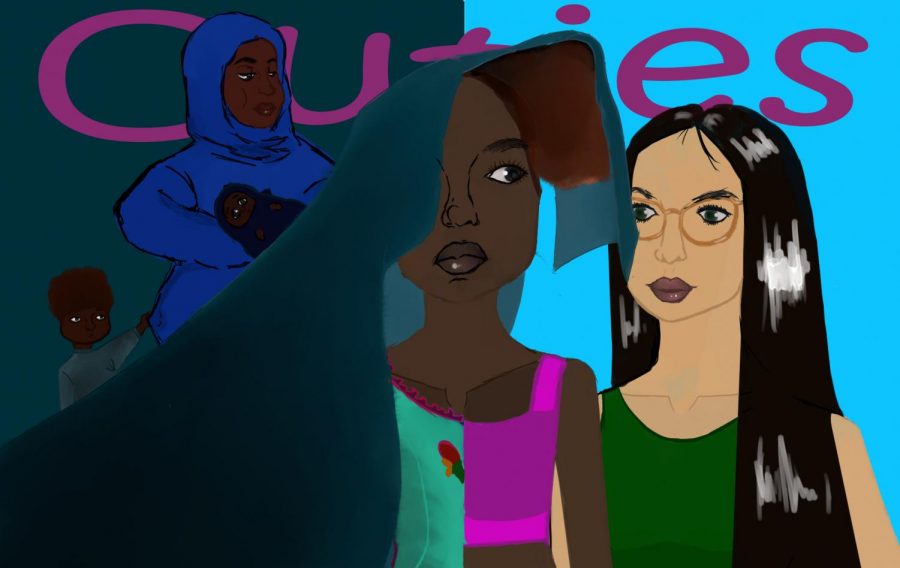The Disturbing Message of Cuties
Cuties, a 2020 French coming-of-age story released at the Sundance Film Festival. It follows ll-year-old Muslim child Amy, who seeks refuge from her conservative household with girls that practice explicit dances in their free time.
October 26, 2020
Cuties is a 2020 French coming-of-age story released at the Sundance Film Festival. It follows ll-year-old Muslim child Amy, who seeks refuge from her conservative household with girls that practice explicit dances in their free time.
Cuties installment on Netflix sparked massive backlash, partially from the synopsis of the film (twerking as a chosen highlight of interest), and partially due to the hypersexualized cover, in which the child leads posed with thrust-out chests in booty shorts and crop tops.
When the film finally released on Netflix, it didn’t fare much better. Viewers were quick to point out the many disturbing crotch shots, lengthy gyration montage, and the entirely unnecessary strip dance, courtesy of the 11-year-old protagonist, to a security guard.
What could’ve been a poignant social commentary devolved into vulgar, exploitative, and crude. To the level that it’s been deemed “pedophile bait” and for good reason, with viewers promoting a boycott of Netflix and political figures clamoring to launch an investigation of the movie set.
The problem comes not from the relevant commentary but the way the movie went about it. Implying without showing would have improved Cuties infinitely. But relying on a heavily pedophilic lens to paint anti-pedophilic themes was not the way to go about it. Cuties fed into the very subject it was trying to criticize.
It’s not as if the message had a bad foundation. A trend of bombarding children with sexual imagery has led to normalized promiscuity starting younger and younger. Hypersexualization, especially for young girls, is an ongoing problem. Just this year, Tik Tok, an app made by adults for underage children, exploded with the “Foreigner challenge”, which caused many teens to release explicit photos of themselves online. In Cuties, they even dance “WAP” from Cardi B.’s popular music video, in which girls hump the floor and later became its own Tik Tok challenge. Even prior to the questionable prominence of 15 to 16 year old “Tik Tok stars,” Music.ly had no surveillance or protection for the underage nudity rampant on the app.
The problem isn’t just limited to social media either. Prior to the film, there were reality TV shows like Toddlers and Tiaras or Dance Moms, which featured little girls wearing skin-tight outfits and performing promiscuous routines for a panel of adult judges to rate, leaning into the sexualization of female-based competitions. Even worse yet is that this is normalized by the large audiences, who often dismiss the problematic environment as integral parts of American culture.
These were all subjects of the titular film, Cuties, but any clumsy attempts at addressing these very real problems were undermined by the uncomfortable leer of the camera lens.
As the catalyst for Amy’s spiral downwards, religious extremism is an important factor for how the film got to Netflix in the first place, and is a part of its controversy. While many stories explore the negative impacts of religion, especially in tandem to patriarchal households, white-dominant countries primary portrayal of Muslim characters invalidate or villainize the religion. Acknowledging that anti-Muslim sentiments helped bolster Cuties audience, especially in its home country where hatred for Muslims is rampant, exposes another layer of controversy that relies on voyeuristic sensationalism to justify racism against Muslim people.
The question remains of how the film could do better. Many proposed hiring adult actors who looked young; but that doesn’t solve the chief problem of the specific age group between child and pre-teen. It wouldn’t be nearly so impactful if the actors looked teenaged.
Another suggestion was to simply cut out any scenes which emphasized Amy and her friend’s prepubescent bodies, and replace them with implied sexual moments. That would’ve allowed the ideas they were trying to convey to also respect the young actresses.
Personally, my solution would be to change mediums altogether; Cuties could’ve been an animated film with adult voice actors. This enables creative work-arounds that used symbols and distortion to encompass Amy’s developing relationship with her sexuality and her body. Depicting the dances in morose, negative ways could’ve heightened the tension between reconciling her family’s view of growing up as opposed to her own.
Cuties was a flop for its intended purpose, but the deeper problems at work bring into question how first-world societies enable young exposure to inappropriate content. The problem doesn’t go away with the removal of a film or two, it stems from a fixation on hypersexualization of all media, only absorbed by younger generations. The controversy provides a basis for conversation or new guidelines to monitor media platforms and shield children operating on those sites.










